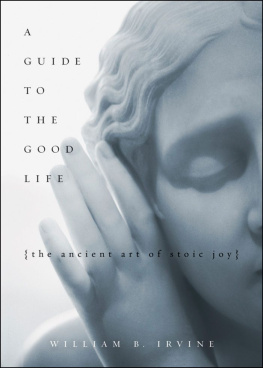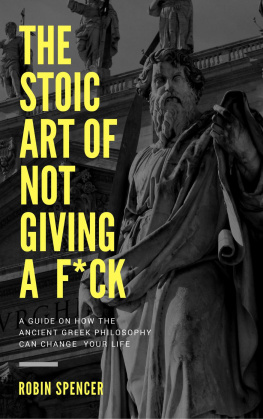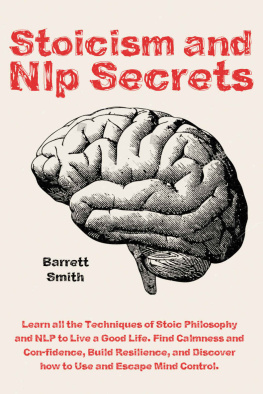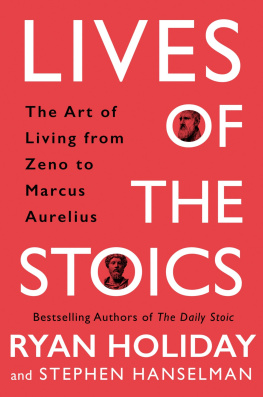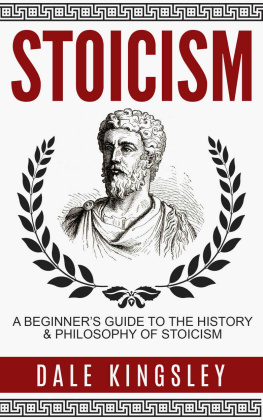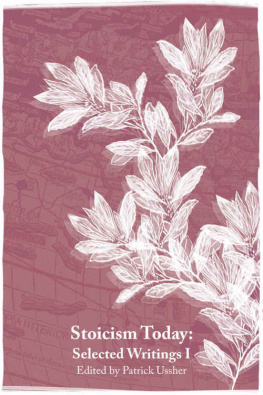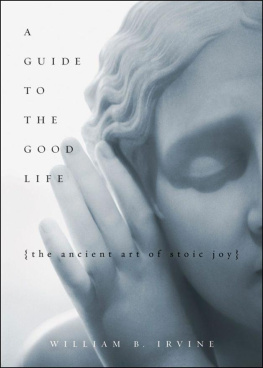A Guide to the Good Life
A Guide to the Good Life
The Ancient Art of Stoic Joy
William B. Irvine


Oxford University Press, Inc., publishes works that further Oxford Universitys objective of excellence in research, scholarship, and education.
Oxford New York
Auckland Cape Town Dares Salaam Hong Kong Karachi
Kuala Lumpur Madrid Melbourne Mexico City Nairobi
New Delhi Shanghai Taipei Toronto
With offices in
Argentina Austria Brazil Chile Czech Republic France Greece
Guatemala Hungary Italy Japan Poland Portugal Singapore
South Korea Switzerland Thailand Turkey Ukraine Vietnam
Copyright 2009 by William B. Irvine
Published by Oxford University Press, Inc.
198 Madison Avenue, New York, NY 10016
www.oup.com
Oxford is a registered trademark of Oxford University Press
All rights reserved. No part of this publication may be reproduced, stored in a retrieval system, or transmitted, in any form or by any means, electronic, mechanical, photocopying, recording, or otherwise, without the prior permission of Oxford University Press.
Library of Congress Cataloging-in-Publication Data
Irvine, William Braxton, 1952
A guide to the good life : the ancient art
of Stoic joy / William B. Irvine.
p. cm.
Includes bibliographical references and index.
ISBN 978-0-19-537461-2
1. Stoics. I. Title.
B528.178 2008
171.2dc 22 2008010563
1 3 5 7 9 8 6 4 2
Printed in the United States of America
on acid-free paper
In memory of Charlie Doyle,
who taught me to keep my head in the boat
even when Im not rowing.
Contents
PART ONE
THE RISE OF STOICISM
ONE
Philosophy Takes an Interest in Life
TWO
The First Stoics
THREE
Roman Stoicism
PART TWO
STOIC PSYCHOLOGICAL TECHNIQUES
FOUR
Negative Visualization: Whats the Worst That Can Happen?
FIVE
The Dichotomy of Control: On Becoming Invincible
SIX
Fatalism: Letting Go of the Past and the Present
SEVEN
Self-Denial: On Dealing with the Dark Side of Pleasure
EIGHT
Meditation: Watching Ourselves Practice Stoicism
PART THREE
STOIC ADVICE
NINE
Duty: On Loving Mankind
TEN
Social Relations: On Dealing with Other People
ELEVEN
Insults: On Putting Up with Put-Downs
TWELVE
Grief: On Vanquishing Tears with Reason
THIRTEEN
Anger: On Overcoming Anti-Joy
FOURTEEN
Personal Values: On Seeking Fame
FIFTEEN
Personal Values: On Luxurious Living
SIXTEEN
Exile: On Surviving a Change of Place
SEVENTEEN
Old Age: On Being Banished to a Nursing Home
EIGHTEEN
Dying: On a Good End to a Good Life
NINETEEN
On Becoming a Stoic: Start Now and Prepare to Be Mocked
PART FOUR
STOICISM FOR MODERN LIVES
TWENTY
The Decline of Stoicism
TWENTY-ONE
Stoicism Reconsidered
TWENTY-TWO
Practicing Stoicism
Acknowledgments
It takes more than an author to make a book. Allow me, therefore, to thank some of those who contributed to the realization of this work.
Thanks, to begin with, to Wright State University for providing the professional development leave during which the bulk of this book was written. Thanks also to my department for allowing me to teach, in the fall of 2005, a course on Hellenistic philosophy in which I was able to try out an early version of this book.
Thanks to those who (in most cases unwittingly) played a significant role in my program of voluntary discomfort, including Jim McCutcheon of McCutcheon Music, Debbie Stirsman of Inner Dance Yoga Center, and my buddies at Greater Dayton Rowing Association, with a special thanks going to those who had the courage to row one seat behind me: Judy Dryer, Chris Luhn, and Michael McCarty. Thanks also to Michael for helping me explore the world of discomfort provided by the erg and for making valuable suggestions concerning the terminology used in .
Thanks to Cynthia King, who read and commented on my manuscript. Thanks also to Bill King, who, although unwilling to admit allegiance to the Stoic credo, has nevertheless been an inspiration to this Stoic.
Thanks to numerous anonymous readers who helped me sharpen the argument of this book. Thanks also to Cybele Tom at Oxford University Press for being such a patient and persevering literary midwife.
The biggest thanks, though, goes to my wife, Jamie, for giving me the time and especially the space in which to write this book.
A Guide to the Good Life
Introduction
A Plan for Living
WHAT DO YOU WANT out of life? You might answer this question by saying that you want a caring spouse, a good job, and a nice house, but these are really just some of the things you want in life. In asking what you want out of life, I am asking the question in its broadest sense. I am asking not for the goals you form as you go about your daily activities but for your grand goal in living. In other words, of the things in life you might pursue, which is the thing you believe to be most valuable?
Many people will have trouble naming this goal. They know what they want minute by minute or even decade by decade during their life, but they have never paused to consider their grand goal in living. It is perhaps understandable that they havent. Our culture doesnt encourage people to think about such things; indeed, it provides them with an endless stream of distractions so they wont ever have to. But a grand goal in living is the first component of a philosophy of life. This means that if you lack a grand goal in living, you lack a coherent philosophy of life.
Why is it important to have such a philosophy? Because without one, there is a danger that you will mislivethat despite all your activity, despite all the pleasant diversions you might have enjoyed while alive, you will end up living a bad life. There is, in other words, a danger that when you are on your deathbed, you will look back and realize that you wasted your one chance at living. Instead of spending your life pursuing something genuinely valuable, you squandered it because you allowed yourself to be distracted by the various baubles life has to offer.
Suppose you can identify your grand goal in living. Suppose, too, that you can explain why this goal is worth attaining. Even then, there is a danger that you will mislive. In particular, if you lack an effective strategy for attaining your goal, it is unlikely that you will attain it. Thus, the second component of a philosophy of life is a strategy for attaining your grand goal in living. This strategy will specify what you must do, as you go about your daily activities, to maximize your chances of gaining the thing in life that you take to be ultimately valuable.
IF WE WANT to take steps to avoid wasting our wealth, we can easily find experts to help us. Looking in the phone book, we will find any number of certified financial planners. These individuals can help us clarify our financial goals: How much, for example, should we be saving for retirement? And having clarified these goals, they can advise us on how to achieve them.
Suppose, however, that we want to take steps to avoid wasting not our wealth but our life. We might seek an expert to guide us: a philosopher of life. This individual would help us think about our goals in living and about which of these goals are in fact worth pursuing. She would remind us that because goals can come into conflict, we need to decide which of our goals should take precedence when conflicts arise. She will therefore help us sort through our goals and place them into a hierarchy. The goal at the pinnacle of this hierarchy will be what I have called our grand goal in living: It is the goal that we should be unwilling to sacrifice to attain other goals. And after helping us select this goal, a philosopher of life will help us devise a strategy for attaining it.
Next page
